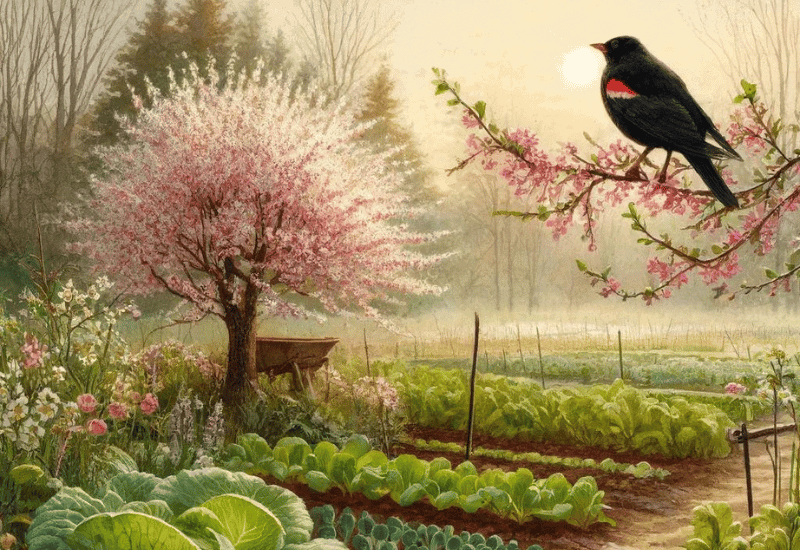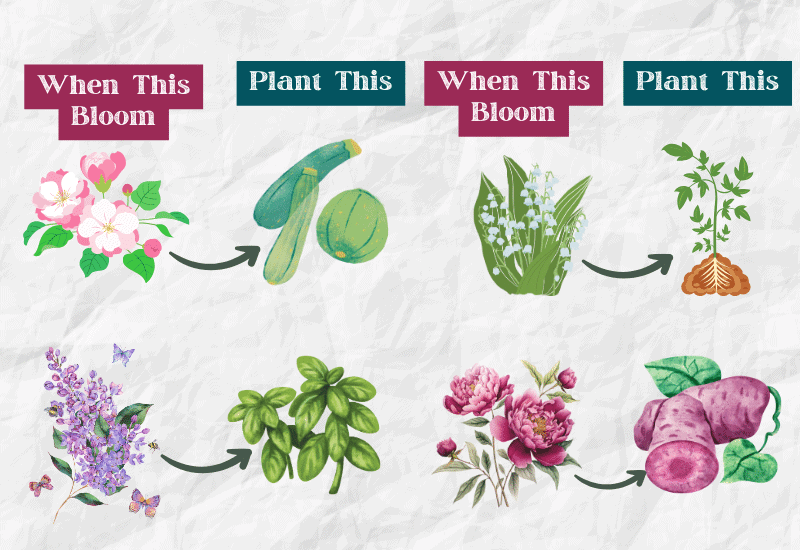
Time to sow, time to transplant, time to prune… There are lots of different dates to keep in mind as a gardener. And how do you keep up with it? How do you decide? Let me tell you a secret and give you a simple way: use phenology! “And what is this?” you may ask? It is the study of natural cycles in relation to climate!
And what does it mean exactly for you and your garden? It means that you can look at Nature to know when it is time to sow, transplant and prune! Of course, you could use a gardening calendar, but we all live in different climate zones, so, if you look at what’s growing, what’s blooming, and what’s fruiting etc., you can get the exact time that is good in your region.
So, follow me and you will have another tool to decide when it is the right time for your gardening chores, and your vegetables, trees and flowering plants will thank you for it!
Phenology: The Signs Nature Gives You to Know When to Sow, Plant and Also Prune!
Phenology is a scientific study of how the cycles of nature work according to climate. It does not concern only plants, but animals too. For example, some insects seem to “know” when it is time to turn from larvae to adults, and match exactly the flowering time of the varieties they feed on.
How do they do it? Well, for example, they feel the right temperature, and the right humidity. Plant daffodils when it’s too hot, for instance, and they won’t blossom. Plant cabbage when the cold season is warming up, and it won’t close into those big heads we eat…
What matters here is that some plants bloom with specific conditions, and some others need the same weather conditions to germinate, so it’s time to sow them.
And gardeners have worked out a series of relationships, so you can simply look at your garden, or Nature in general, and you know it’s time to plant a specific plant, sow another or prune a shrub.
How Can You Use Phenology in Your Gardening?
Ok, I am not telling you not to use a calendar, nor a thermometer, nor to forget the weather forecast… But you can use phenology to give you that extra precision, and also a visual clue to what needs doing in your garden.
Calendars in particular are not “fixed rules” with gardening. The weather changes year on year, not all years are the same, and climate change is making this worse. What’s more, each area has its own microclimate, so, even if you get a specific calendar for your USDA zone, it can only give you a general idea, a window for planting, sowing and pruning.
So, still look at your calendar, check the weather forecast, and use your soil thermometer, but add phenology to guide you as well, as an extra instrument in your toolkit.
I also think it’s a good experience, a learning curve, and it puts you back in touch with Nature, as farmers did long ago (some still do).
And now, without further ado…
35 Phenological Sign to Time Your Gardening Chores
Off we go then, here are 35 tips for you, or signs that it is time for you to plant and prune and transplant in your garden.

1. Prune your roses when forsythia is in bloom.
2. When crocuses bloom, you can plant radishes, parsnips, and spinach.
3. When forsythia is in bloom, you can plant onion sets.
4. Again, when forsythia is blooming, you can transplant lettuce seedlings.
5. When forsythia is flowering, you can also plant peas.
6. When forsythia flowers, you can sow endive and escarole in situ in your garden.
7. When daffodils are blooming, you should plant half-hardy vegetables, such as beets, carrots, and chard.
8. When lilacs grow their first leaves, you can plant cold weather crops like beets, carrots, lettuce, and spinach.
9. When lilacs grow their first leaves, it’s time to plant root crops too.
10. When you see the first leaves on lilacs, you can also plant Brassicaceae like broccoli, kale, cabbage and cauliflower.
11. Wait for dandelions to bloom before you plant potatoes.
12. When you see the first leaves on maple trees, you can start planting perennial flowers.
13. When quince is blossoming, it’s time to transplant cabbage and broccoli seedlings.
14. Do not plant bush beans until apple trees have blossomed.
15. Only plant pole beans and cucumbers only after apple tree flowers have fully fallen.
16. Wait till lilacs are in full bloom, before you plant squash and tender annual flowers.
17. When lily-of-the-valley is in full flower, you can transplant tomato seedlings into your garden.
18. You can sow morning glories only when maple leaves are adult and full size.
19. When the bearded irises are blooming, it is time to plant eggplant and pepper seedlings.
20. Wait to plant hot season melons such as cantaloupe till peonies are in full bloom.
21. When lilacs flower, you can also sow hardy hers, like parsley, chives and chervil.
22. When you see that lilac leaves are growing, you can plant calendula and alyssum too.
23. But wait till lilacs are in full bloom before planting tender herbs, like basil and mint.
24. And when lilacs are in full bloom, you can also plant marigolds and geraniums.
25. When you see that nettle shoots are growing, you can sow spinach in your garden.
26. When forsythia and dandelions are both flowering, you can sow turnips in your garden, in situ.
27. When peonies are flowering, you can transplant okra seedlings.
28. When peonies bloom, you can also plant sweet potatoes in the soil.
29. When chokecherry and aspen start to grow leaves, it’s safe to sow hardy annuals as well as pansies and snapdragons.
30. When daylilies are in flower, you can plant tomatoes, peppers and corn.
31. When crabapples flower and when lilacs blossom, you can sow zucchini in your garden.
32. Wait till all lilac flowers have wilted before planting cucumber, squash and pumpkin.
33. If dogwood is at the peak of its bloom, you can transplant tomato seedlings.
34. When lily of the valley flowers, it’s yet another sign you can plant tomato seedlings.
35. When oak leaves are the size of a mouse’s ear (when they start), you can plant corn.
And now, look around you, it may be time to do some sowing, planting and maybe even pruning!
Is Phenology the Weather Wizard of Gardening?
Phenology isn’t perfect, but let’s face it, what in gardening is? This method doesn’t rely on a crystal ball. Instead, it embraces the capricious moods of Mother Nature. Wildfires, those uninvited guests at the garden party, can throw shade—literally—by blocking sunlight and cooling the air.
So, what’s phenology’s secret sauce? Phenology is like that old friend who gives you the inside scoop. It tells you, “Hey, the cherry blossoms are out, so maybe give those tomato plants a shot.” But remember, it’s more of a guideline than a guarantee. It’s like looking at a weather forecast—you get the gist, but pack an umbrella just in case.
So, you’ve got your garden all set, following nature’s hints, and feeling pretty good about it. But then, out of the blue, comes a frost so nippy it could make a polar bear shiver. That’s the gamble we take when we play in nature’s backyard. No calendar or fancy tech can predict every twist and turn on this wild ride.
The bottom line? Phenology is your co-pilot, not the pilot. It’s there to give you a leg up, to whisper little secrets about when to sow and when to reap. But it can’t control the weather, and it certainly can’t stop those sneaky, out-of-season chills. So, plant with care, but always have a plan B—that’s the spice of gardening life!

Written By
Amber Noyes
Amber Noyes was born and raised in a suburban California town, San Mateo. She holds a master’s degree in horticulture from the University of California as well as a BS in Biology from the University of San Francisco. With experience working on an organic farm, water conservation research, farmers’ markets, and plant nursery, she understands what makes plants thrive and how we can better understand the connection between microclimate and plant health. When she’s not on the land, Amber loves informing people of new ideas/things related to gardening, especially organic gardening, houseplants, and growing plants in a small space.

